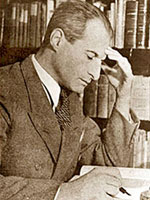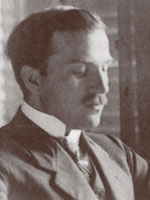The Seim of Poland republic proclaimed the 2013 as the year of composer Witold Lutosławski, poet Julian Tuwim and chemist Jan Czochralski. We suggest you to find out more about those famous polish workers of culture and science.
 |
Witold Lutosławski
Witold Lutosławski was born on the 25th of January 1913 in the family of political figure Józef Lutosławski. He started composing at the age of 9 years (Prelude for the piano). He practiced playing the piano and the violin. In 1937 he graduated from the Warsaw music conservatory. At the same time he studied math in Warsaw University.
His lecturer was famous Russian-Polish composer, Professor Witold Maliszewski – the favorite pupil of M. O. Rimsky-Korsakov and founder of Odessa music conservatory. It was Maliszewski who has given a grounding of Lutosławski composer’s talent.
Lutosławski was versant with compositions of Russian and Ukrainian composers. Especially he was fascinated with famous 20th century composer Igor Stravinsky. He also investigated folklore. As a composer, he was greatly influenced by Karol Szymanowski.
Lutosławski compositions are well-known. They were performed by the best musicians in the world that are Mstislav Rostropovich, Heinz Holliger, Dietrich Fischer-Dieskau, Anne-Sophie Mutter, Dawn Upshaw, Georg Solti, Esa-Pekka Salonen, Antoni Wit and other.
Witold Lutosławski died on the 7th of February 1994.
|
 |
Julian Tuwim
Julian Tuwim was born on the 13th of September 1894 in Lodz. During a period of 1916-1918 he studied legal studies and philosophy in Warsaw University.
He made his debut with his first poem “Prayer” published in “Kurjer Warszawski”. He was one of those who had founded experimental poets group “Skamander” in 1919. In 1930th he sharply criticized fascism in his poems.
Being a poet he was greatly influenced by such poets as W. Whitman and A. Rimbaud. He often used everyday language in his poems. He also was well-known translation theorist, theorist of literature and bibliographer. He translated works of Russian classics (O.S. Pushkin, O.S. Griboedov, B. L. Pasternak) into polish. Pushkin’s book of poems translated by Tuwim („Pushkin’s bandore”) was highly estimated by Vladislav Khodasevych.
On the territory of former USSR Julian Tuwim is famous for his collection for children translated by S. Marshak and S. Mikhalkov.
Julian Tuwim died on the 27th of December 1953.
|
 |
Jan Czochralski
Jan Czochralski was born on the 23d of October 1885 in Kcynia in the family of woodworker. At the beginning of the 20th century he moved to Berlin where he worked in pharmaceutical company. He graduated from Berlin technical university with a degree in “Chemistry of metals” and in 1907 he started working as engineer in German company AEG.
In 1917 Czochralski moved to Frankfurt on the Main where he founded research laboratory “Metallbank und Metallurgische Gesellschaft”. In 1919 he was one of the founders of German Association of Metals Sciences (Deutsche Gesellschaft fur Metallkunde) which was led by him till 1925.
In 1928 he went back to his Motherland on invitation of the president of Poland Ignacy Mościcki. In 1929 he earned a degree of honorary doctorate (doktor honoris causa) and started working as professor of chemistry on the faculty of chemistry at the Warsaw Polytechnic. The faculty of metallurgical engineering and materials science were created for him. Soon he established the Institute of metallurgical engineering and materials science at the Warsaw Polytechnic.
During the years of the World War II Jan Czochralski used his contacts with Germans in order to discharge people from prisons. It is thanks to him such professors as Maryana Sviderka and Stanislava Poreyko were discharged from extermination camps. Intermediary was his daughter Leonia who was a friend of a daughter of the Germany Security Service head. Czochralski has saved about 50 people in such a way.
Jan Czochralski is the author of the famous method of growing semiconductors crystals from liquid-alloy by taking them up from the free surface. This method was called after him. Silicon monocrystals grown with the help of this method are used for mass microprocessors production. They are also used in helioenergetics and in the semiconductor devices production. Moreover, crystals grown with the help of Czochralski method are used as gem stones and in scientific investigations (for example, bismuth germinate – BiGeO – is used as scintillate material in nuclear physics and high energy physics).
Jan Czochralski died on the 22nd of April 1953. He is buried at the cemetery in his Motherland – Kcynia. Only in 1998 the brass with his name was placed on the unknown grave.
|
Małgorzata Grausam, Hanna Bidniuk.